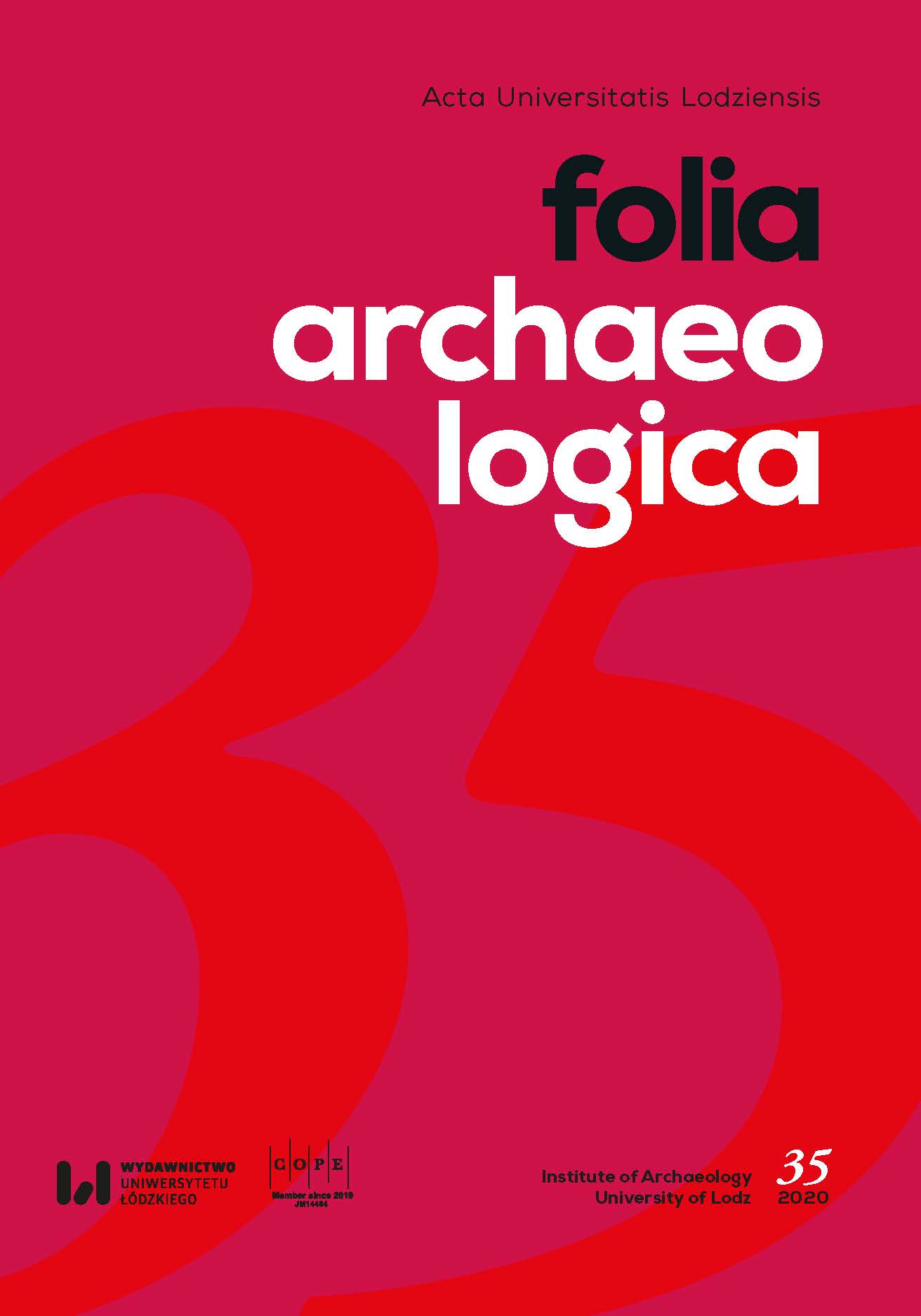Obuwie z wolną piętą z południowej krypty w Piasecznie, woj. pomorskie
DOI:
https://doi.org/10.18778/0208-6034.35.09Słowa kluczowe:
skórzane obuwie z wolną piętą, mule, pantofle, kapcie, XVIII w., Piaseczno, PolskaAbstrakt
Dyskusja na temat nowożytnego obuwia jest dość ograniczona ze względu na szczupłość źródeł pozyskiwanych w czasie badań archeologicznych. Jednak tę lukę uzupełniają w jakiejś mierze kolekcje muzealne i ikonografia. Dlatego tak istotne jest publikowanie kolejnych znalezisk, bo tylko w oparciu o nie można podjąć dyskusję na temat pojedynczych egzemplarzy obuwia z wolną pietą. Taka właśnie para została znaleziona w południowej krypcia kościoła pw. Narodzenia Najświętszej Marii Panny w Piasecznie. Należy ona do unikatowych obiektów, ponieważ można określić jej wszystkie elementy oraz jakość skóry, która raczej należała do grubych. Ogólny stan zachowania obuwia można określić jako dobry. Powierzchnia skóry na podeszwach, obcasach oraz przyszwach świadczy o intensywnym użytkowaniu wyrobu za życia właściciela. Zostały one wykonane bez rozróżnienia kroju dla prawej i lewej stopy, ale odkształcenia wynikające ze znoszenia pozwalają ocenić, który pantofel noszono, na której stopie.
Opisywana powyżej para pantofli odnaleziona w Piasecznie stanowi ciekawy przyczynek do dyskusji na temat obuwia z wolną piętą w ogóle. Podstawową trudność w interpretacji takiego znaleziska może sprawiać określenie funkcji, jaką pełniło. Funkcje obuwia ochronnego i obuwia domowego do pewnego momentu lub w specyficznych okolicznościach mogły przenikać się. Jednak wydaje się, że w czasach nowożytnych konstruowano oddzielne pary obuwia służącego jednym i drugim celom. Niestety, jedynymi przesłankami pozwalającymi skłaniać się ku którejś z tez są raczej subiektywne kategorie masywności i wielkości obuwia oraz różnorodność zastosowanych surowców.
W artykule posłużono się szeregiem określeń obuwia z wolną piętą (patynki, mule, mulety, kapcie, pantofle), by unaocznić bogactwo językowe. Z pewnością w latach minionych określone modele miały swoje nazwy, niestety szczupłość przekazów nastręcza wielkie trudności w rekonstruowaniu dawnej rzeczywistości językowej.
Pobrania
Bibliografia
Blusiewicz K. (2009), Warsaw Footwear in the 14th–18th Century. From the Archaeological Collection in the Historical Museum of the City of Warsaw, [in:] Archeologia dawnej Warszawy, I, Muzeum Historyczne m. st. Warszawy, Warszawa.
Google Scholar
Cassagnes-Brouquet S. (2009), La vie des femmes au Moyen Âge, Ouest-France, Rennes.
Google Scholar
Ceynowa B. (2004), Późnośredniowieczne patynki gdańskie z badań na Wyspie Spichrzów, “Pomorania Antiqua”, 19, p. 139–153.
Google Scholar
Ceynowa B. (2005), Patynki z badań na Wyspie Spichrzów w Gdańsku/Aus Untersuchungen an der Speicherinsel in Gdańsk (Danzig) stammende Pantoffeln, [in:] H. Paner, M. Fudziński (ed.), XIV Sesja Pomorzoznawcza, vol. II, Od wczesnego średniowiecza do czasów nowożytnych, Muzeum Archeologiczne, Gdańsk, p. 319–326.
Google Scholar
Ceynowa B. (2009), Obuwie ochronne znalezione w Gdańsku – problematyka i metody badawcze, [in:] In gremio – In praxi. Studia nad średniowiecznym skórnictwem, Wydawnictwo IAiE PAN, Szczecin, p. 9–112.
Google Scholar
Cnotliwy E. (1994), Późnośredniowieczne obuwie ochronne z badań na Podzamczu w Szczecinie, “Materiały Zachodniopomorskie”, 40, p. 201–210.
Google Scholar
Drążkowska A. (2011), Historia obuwia na ziemiach polskich od IX do końca XVIII wieku, Wydawnictwo Naukowe Uniwersytetu Mikołaja Kopernika, Toruń.
Google Scholar
Dudziński T., Grupa M., Grupa D., Krajewska M., Majorek M., Nowak M.,
Google Scholar
Nowak S., Przymorska-Sztuczka M., Wojciechowska A. (2015), Tajemnice szczuczyńskich krypt, vol. III, Towarzystwo Przyjaciół 9 PSK. Uniwersytet Mikołaja Kopernika, Grajewo–Toruń.
Google Scholar
Durian-Ress S. (1991), Schuhe. Vom späten Mittelalter bis zur Gegenwart, Hirmer, Munich.
Google Scholar
Goubitz O., Driel-Murray van C., Groenman-van Waateringe W. (2001), Stepping through the Time. Archaeological Footwear from Prehistoric Times until 1800, SPA Uitgevers, Zwolle.
Google Scholar
Grew F., Neergaard de M. (2001), Shoes and Patterns. (Medieval Finds from Excavation in London), vol. II, London.
Google Scholar
Grupa D. (2019), Laying Waste in Archaeological Sites. The Problems of Damage to Historical Sacred Objects as a Result of Human Activity, “Fasciculi Archaeologiae Historicae”, 32, p. 189–199, https://doi.org/10.23858/FAH32.2019.012
Google Scholar
DOI: https://doi.org/10.23858/FAH32.2019.012
Grupa M. (2012), Wełniane tekstylia pospólstwa i plebsu gdańskiego (XIV–XVII w.) i ich konserwacja, Wydawnictwo Naukowe Uniwersytetu Mikołaja Kopernika, Toruń.
Google Scholar
Grupa M. (2018), Kultura materialna w świetle badań archeologicznych w sanktuarium w Piasecznie, [in:] W. Pikor (ed.), Kultura materialna i duchowa sanktuarium w Piasecznie, Wydawnictwo “Bernardinum”, Pelplin, p. 33–43.
Google Scholar
Grupa M., Grupa D., Kozłowski T., Krajewska M., Majorek M., Nowak M., Nowak S., Przymorska-Sztuczka M., Wojciechowska A., Dudziński T. (2014), Tajemnice szczuczyńskich krypt, vol. II, Towarzystwo Przyjaciół 9 PSK. Uniwersytet Mikołaja Kopernika, Grajewo–Toruń.
Google Scholar
Grupa M., Kozłowski T., Jankauskas R., Grupa D., Krajewska M., Krakowska S., Majorek M., Mosiejczyk J., Nowak M., Nowak S., Przymorska-Sztuczka M., Wojciechowska A. (2015), Secrets of the Crypt in St. Ann’s Chapel. Tajemnice krypty w kaplicy św. Anny, Stowarzyszenie Centrum Aktywnych, Gniew.
Google Scholar
Gutkowska-Rychlewska M. (1968), Historia ubiorów, Państwowe Wydawnictwo Szkolnictwa Zawodowego, Warszawa.
Google Scholar
Każdy krok zostawia ślad. Obuwie historyczne ze zbiorów Muzeum Archeologicznego w Gdańsku. Katalog wystawy (2016), Muzeum Archeologiczne, Gdańsk.
Google Scholar
Klint P., Rzemieniecki K., Węglorz J. (2018), Źródła szlacheckie z ksiąg grodzkich i ziemskich ziemi halickiej z XVII wieku, Wydawnictwo Uniwersytetu Wrocławskiego, Wrocław.
Google Scholar
Kulesz A. (2019), Women’s Shoes from the Crypt of the Church of the Name of the Holy Virgin Mary in Szczuczyn, Podlaskie Voivodship, “Analecta Archaeologica Ressoviensia”, 14, p. 155–168, https://doi.org/10.15584/anarres.2019.14.11
Google Scholar
DOI: https://doi.org/10.15584/anarres.2019.14.11
Pescio C. (2017), Malarstwo holenderskie. Złoty wiek, Wydawnictwo Arkady, Warszawa.
Google Scholar
Pratt L., Woolley L. (2008), Shoes, V&A Publishing, London.
Google Scholar
Sikora R., Szleszyński R. (2014), Husaria Rzeczypospolitej, Warszawa.
Google Scholar
Swann J. (1982), Shoes, Batsford LTD, London.
Google Scholar
Turnau I. (1983), Polskie skórnictwo, Zakład Narodowy im. Ossolińskich, Wrocław.
Google Scholar
Wywrot-Wyszkowska B. (2002), Późnośredniowieczne patynki z lokacyjnego Kołobrzegu, “Przegląd Archeologiczny”, 50, p. 103–110.
Google Scholar
Wywrot-Wyszkowska B. (2008), Skórnictwo w lokacyjnym Kołobrzegu. XIII–XV wiek, Instytut Archeologii i Etnologii PAN, Szczecin.
Google Scholar
Zimmerman H. (2007), Textiel in context. Een analyse van archeologische textielvondsten uit 16e-eeuws Groningen, Stichting Monument & Materiaal, Groningen.
Google Scholar
Pobrania
Opublikowane
Jak cytować
Numer
Dział
Licencja

Utwór dostępny jest na licencji Creative Commons Uznanie autorstwa – Użycie niekomercyjne – Bez utworów zależnych 4.0 Międzynarodowe.












